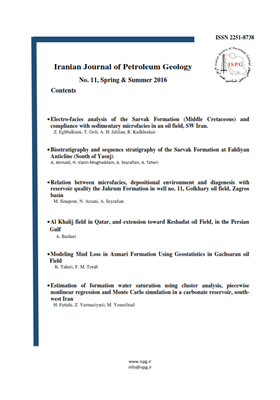Estimation of formation water saturation using cluster analysis, piecewise nonlinear regression and Monte Carlo simulation in a carbonate reservoir, south-west Iran
Subject Areas :Hadi Fattahi 1 * , zahra Varmazyari 2 , Mostafa Yosefi rad 3
1 -
2 -
3 -
Abstract :
Estimation of formation water saturation (Sw) using log data is an important approach in the oil exploration and characterization of a hydrocarbon reservoir. Therefore, it seems that the proper prediction/simulation of Sw is essential. The first objective of this study was to develop a predictive model for Sw estimation based on hybrid cluster analysis with piecewise nonlinear regression, and after that, using the developed model, Sw was simulated by the Monte Carlo simulation (MCS). In order to achieve objectives of this study, a group of 909 data points was used for model construction and 302 data points were employed for assessment of model. The obtained results of MCS modeling indicated that this approach is capable of simulating Sw ranges with a good level of accuracy. The mean of simulated Sw by MCS was obtained as 0.28 m, while this value was achieved as 0.29 m for the measured one. Furthermore, a sensitivity analysis was also conducted to investigate the effects of model inputs on the output of the system. The analysis demonstrated that RHOB is the most influential parameter on Sw among all model inputs. It is noticeable that the proposed hybrid cluster analysis with piecewise nonlinear regression and MCS models should be utilized only in the studied area and the direct use of them in the other conditions is not recommended.
[1] Kamel M. H., Mabrouk W. M. 2002, An equation for estimating water saturation in clean formations utilizing resistivity and sonic logs: theory and application: J Pet Sci Eng, 36, 159-168.#
[2] Amiri M., Zahedi G., Yunan M. H. 2015, Reducing predictive uncertainty in log-derived water saturation models in a giant tight shaly sandstones–A case study from Mesaverde tight gas reservoir: J Natu Gas Sci Eng, 23, 380-386.#
[3] Mabrouk W. M., Soliman K. S., Anas S. S. 2013, New method to calculate the formation water resistivity (R w): J Pet Sci Eng, 104, 49-52.#
[4] Lee M., Collett T. 2011, In-situ gas hydrate hydrate saturation estimated from various well logs at the Mount Elbert Gas Hydrate Stratigraphic Test Well, Alaska North Slope: Mar Petrol Geol, 28, 439-449.#
[5] Worthington P. F. 1993, The uses and abuses of the Archie equations, 1: The formation factor-porosity relationship: J Appl Geophys, 30, 215-228.#
[6] Na’imi S., Shadizadeh S., Riahi M., Mirzakhanian M. 2014, Estimation of reservoir porosity and water saturation based on seismic attributes using support vector regression approach: J Appl Geophys, 107, 93-101.#
[7] Habibi M. J., Mokhtari A. R., Baghbanan A., Namdari S. 2014, Prediction of permeability in dual fracture media by multivariate regression analysis: J Pet Sci Eng, 120, 194-201.#
[8] Huang D., Sima L., Wu F., Wang L., Li Q. 2015, Estimating saturation exponent from NMR logging: Arab J Geosci, 8, 6771-6778.#
[9] Al-Bulushi N., King P. R., Blunt M. J., Kraaijveld M. 2009, Development of artificial neural network models for predicting water saturation and fluid distribution: J Pet Sci Eng, 68, 197-208.#
[10] Vadapalli U., Srivastava R., Vedanti N., Dimri V. 2014, Estimation of permeability of a sandstone reservoir by a fractal and Monte Carlo simulation approach: a case study: Nonlinear Processes in Geophysics, 21, 9-18.#
[11] Quandt R. E. 1958, The estimation of the parameters of a linear regression system obeying two separate regimes: Journal of the american statistical association, 53, 873-880.#
[12] Michel O. J., Hero A. O., Badel A. E. 1999, Tree-structured nonlinear signal modeling and prediction: IEEE Transactions on Signal Processing, 47, 3027-3041.#
[13] Pandit Y. P., Badhe Y. P., Sharma B., Tambe S. S., Kulkarni B. D. 2011, Classification of Indian power coals using K-means clustering and Self Organizing Map neural network: Fuel, 90, 339-347.#
[14] Alpaydin E. (2014) Introduction to machine learning. MIT press, #
[15] Alsabti K., Ranka S., Singh V. 1997, An efficient k-means clustering algorithm.#
[16] Ding C., He X. K-means clustering via principal component analysis. In: Proceedings of the twenty-first international conference on Machine learning, 2004. ACM, p 29#
[17] Ng H., Ong S., Foong K., Goh P., Nowinski W. Medical image segmentation using k-means clustering and improved watershed algorithm. In: 2006 IEEE Southwest Symposium on Image Analysis and Interpretation, 2006. IEEE, pp 61-65#
[18] Kawrakow I. 2000, Accurate condensed history Monte Carlo simulation of electron transport. II. Application to ion chamber response simulations: Medical physics, 27, 499-513.#
[19] Milner R. (1971) An algebraic definition of simulation between programs. Citeseer, #
[20] Arian M., Mohammadian R. 2011, Analysis of Fractures in the Asmari Reservoir of Marun Oil Field (Zagros): Geosciences, 20, 88-96.#

